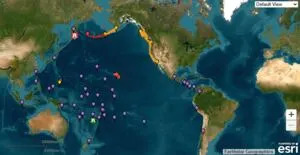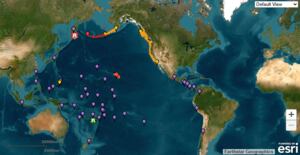
Tsunami advisory issued for Washington coast after massive 8.7 quake off Russia
A tsunami advisory remains in effect for Washington’s outer coast following a powerful magnitude 8.7 earthquake off the Kamchatka Peninsula, the National Tsunami Warning Center said in an updated alert Tuesday evening.
The earthquake struck at 4:25 p.m. Pacific time and was centered 80 miles southeast of Petropavlovsk, Kamchatka, and 315 miles southwest of Bering Island. It occurred at a depth of 46 miles.
As of 6:27 p.m., the tsunami watch for Southeast Alaska and parts of the Alaska Peninsula has been canceled, but tsunami warnings remain in effect for portions of the Aleutian Islands.
The advisory continues for the coasts of Washington, Oregon, California, British Columbia, and parts of southern Alaska.
For Washington, the advisory applies to the outer coast from the Oregon-Washington border to Slip Point, including the Columbia River estuary and the Strait of Juan de Fuca.
Forecasts show that tsunami activity could begin reaching Washington coastal communities late Tuesday night.
Estimated arrival times include La Push at 11:35 p.m., Neah Bay at 11:40 p.m., Long Beach at 11:45 p.m., Moclips at 11:50 p.m., and Westport at 11:55 p.m. Port Angeles, Port Townsend, and other areas around the Puget Sound could see minor activity after midnight.
Tsunami waves are not expected to be large in Washington.
Forecasts indicate maximum wave heights along the coast could range from less than a foot to about 1.4 feet in some areas like Moclips.
No tsunami observations had been recorded as of the latest update.
Emergency officials are urging coastal residents to stay away from the shore, harbors, marinas, and inlets.
Dangerous currents and unusual wave behavior are still possible even if large waves do not appear.
“If you are near the coast and feel strong shaking or see the water rapidly recede, move inland and to higher ground immediately,” the advisory warned.
Boat operators are advised to move vessels to deeper water, if time allows and it is safe to do so.
The public is strongly urged not to go to the beach to watch for tsunami waves.
The tsunami may appear as a rapidly rising tide, a series of strong waves, or even a frothy wall of water.
The strongest waves may not be the first to arrive, and hazardous conditions could persist for hours.
Additional updates are expected within the hour. For the latest information, visit tsunami.gov.
A tsunami warning has also been issued for Hawaii.
According to tsunami.gov, the estimated time in Hawaii for the first tsunami wave is 7:17 p.m. Hawaiian time.

